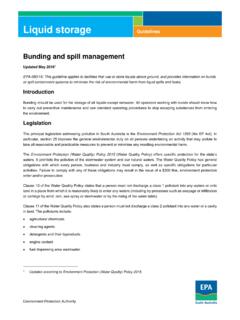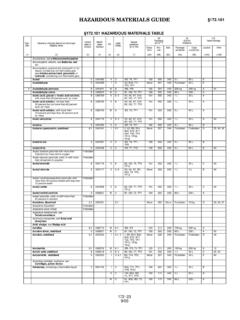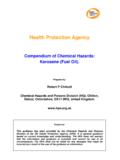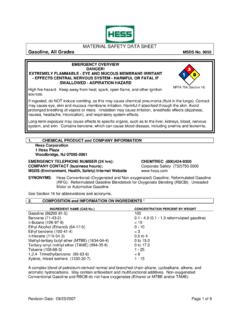Transcription of RNA Isolation with TRIzol (Invitrogen) and Qiagen RNAeasy
1 1 RNA Isolation with TRIzol ( invitrogen ) and Qiagen RNAeasy This protocol applies to: Neuroblastoma (NBL; prior to 2013 only) The protocol herein describes the procedures used by Nationwide Children s Hospital to process disease tissues for RNA and/or DNA subsequently used for characterization in the NCI s TARGET initiative. All nucleic acid samples used in TARGET projects were quality tested for consistency using picogreen quantification and SSTR genotyping methods, regardless of where the nucleic acid was originally extracted. I. PRINCIPLE The invitrogen Life Technologies TRIzol Reagent (Total RNA Isolation Reagent) is a ready-to-use reagent for the Isolation of total RNA from cells and tissues for use in PCR analysis. TRIzol reagent is a mono-phasic solution of phenol and guanidine isothiocyanate. During tissue homogenization or lysis, the TRIzol reagent maintains RNA integrity, while disrupting cells and dissolving cell components.
2 Addition of chloroform followed by centrifugation separates the solution into an aqueous phase and an organic phase. RNA remains in the aqueous phase and is recovered by precipitation with isopropanol. The RNA is redissolved in Nuclease-free water. Patient RNA is stored for research requests. II. SPECIMEN A. Type Solid tumor tissue B. Handling Conditions Standard Precautions must be followed when handling all solid tissue samples. Samples must be stored in a -80 C freezer. C. Sample Preparation The solid tumor tissue may be fresh or frozen. Fresh tumor is suboptimal due to likely RNA degradation. Optimum sample size is a small cube of tissue weighing between 50-70 mg. Testing will be attempted on all samples, irrespective of percentage of viable tumor. However, if there is less than 30% viable tumor and the testing results are negative, no result will be reported. 2 D. Indications for Study RNA Isolation is necessary for any assays which analyze the presence or quantity of mRNA transcripts, RT-PCR.
3 III. REQUIRED EQUIPMENT, SUPPLIES AND REAGENTS A. Equipment Capsule Centrifuge Magnetic Stir Plate Microcentrifuge (Eppendorf 5415R) Omni H Homogenizer, 115V, 60Hz or TissueLyser (120V, 50/60 Hz) Pipetters - Adjustable, 1-10 L, 5-20 L, 20-200 L, 100-1000 L Nanodrop Vortex Mixer Water Bath B. Supplies Aerosol Barrier Pipet Tips Disposable Homogenizers Dry ice Forceps PPE (Gloves, Lab Coat) 50 mL Serological Pipette Ice Labels (TEC, x1 and 2 ) mL Micrewtube Tubes, screw cap (Milian, T338-2S) mL Micrewtube Tubes, screw cap (Milian, T338-5S) Yellow cap inserts (Milian, TIL-21) Petri dishes (35x10 mm) 50 mL Polypropylene Centrifuge Tube Scalpel blades 2 mL Screw-cap Polypropylene Microcentrifuge Tubes 2 mL Safe-Lock Tubes (Eppendorf, Cat# 2236335-2) Stainless Steel Beads, 5 mm (200) ( Qiagen , Cat# 69989) Tube Racks C. Reagents Chloroform (Sigma, Catalog # C2432) 3 Nuclease Free Water (Fisher, Catalog # BP2484-50) 75% Ethanol (-20 C) (Sigma, Catalog # E7023) Isopropanol (Sigma, Catalog # I0398) TRIzol reagent ( invitrogen Life Technologies, Catalog # 15596-026) DNA-free Kit, includes DNAse I buffer, DNase, Inactivation reagent (Ambion, Catalog #1906) IV.
4 WARNINGS / PRECAUTIONS A. Use Standard Precautions when handling all body fluids, tissues and cell cultures. Refer to the Specimen Collection and Handling, GEN-1, for guidelines specific for the Molecular Genetics Laboratory and samples. B. TRIzol reagent is toxic when in contact with skin and if swallowed. It will cause burns. Be sure to wear a lab coat, gloves and safety glasses when working with TRIzol reagent. If in contact with skin, wash immediately with plenty of soap and water. Work in a chemical fume hood. C. To prevent RNase contamination, always wear gloves and change them frequently. Also, use sterile, disposable plasticware and pipettes dedicated strictly to RNA work to prevent cross-contamination with RNases from shared equipment. D. RNA is extremely susceptible to degradation by ribonucleases that are ubiquitous in the environment. To ensure preservation of target RNA or RNA probes, special precautions are needed.
5 Records are maintained to show that RNase-free conditions ( wiping the lab areas with RNaseZAP) are met, with corrective action if conditions are not met. V. REAGENT PREPARATION (INCLUDING STORAGE CONDITIONS) A. TRIzol reagent is used as supplied by invitrogen Life Technologies. It is stored in a refrigerator in a dark container. B. Chloroform and isopropanol are stored at room temperature in the flammable liquids chemical cabinet. C. DNA-free kit from Ambion is stored in a -20oC freezer. D. 75% ethanol 1. To a 50 mL polypropylene centrifuge tube, add mL of 100% ethanol. Next add distilled water to reach a final volume of 50 mL. Invert to mix. 4 2. Label tube appropriately (reagent name, date made, expiration date, storage conditions, NFPA rating and initials) and be sure to mark for RNA USE ONLY. Store in the flammable cabinet. 3. Write preparation information in to the QC Book, under the Prepared Reagents tab.
6 VI. QUALITY CONTROL A. Specimen identification is assured through each phase of handling by assignment of a specific color to each sample. That color (in addition to the lab number and patient initials) is placed on each tube used throughout the procedure. B. At each step in the Isolation , the supernatant or pellet that does not contain the RNA is retained until after Isolation and quantification is completed. All tubes are labeled with the COG number, BPC number and patient initials. VII. PROCEDURE STEPWISE (Follow worksheet for RNA Isolation ) A. Homogenization with TissueLyser (NOTE: Work with one specimen at a time until all specimens are in TRIzol ) 1. Place a 5 mm stainless steel bead in a Safe-Lock tube for each specimen. 2. In a chemical fume hood, add mL of TRIzol reagent to an appropriately labeled 2 mL Safe-Lock Eppendorf tube and place on wet ice. 3. Frozen tissue should remain buried in dry ice until added to TRIzol .
7 The optimum sample size is between 50-70 mg; if over 70 mg, split the sample into two pieces and put into 2 SafeLock tubes (combine these after homogenization). 4. Place the entire tumor into the Safe-Lock tube containing TRIzol . 5. Once all of the samples are in their labeled tubes, place the tubes into the TissueLyser adapter sets. 6. Fix the adapter sets into the clamps (arms) of the TissueLyser. Homogenize the samples for 3 minutes at 25 Hz. If the sample is not fully homogenized, repeat with decreased time and decreased frequency (1 minute, 20 Hz) for no more than 2 additional minutes. For optimal operation, the TissueLyser must always be balanced. 7. Working in a chemical fume hood, transfer the homogenized sample by pipet to a new 2 mL screw cap tube containing mL of TRIzol . Invert tube to mix. Place the tube on wet ice temporarily until ready to proceed to 5 Phase Separation, or on dry ice and then move into a -80 freezer for storage of homogenized sample for future extraction.
8 B. Phase Separation 1. Incubate the homogenized sample for 5 minutes at room temperature. (If tubes are frozen, thaw in a bucket of wet ice before proceeding to room temperature incubation.) 2. In a chemical fume hood, add mL of chloroform per 1 mL of TRIzol reagent. 3. Cap sample tubes securely and shake vigorously by hand for 15 seconds. Incubate the samples at room temperature for 3 minutes. 4. Following the incubation, centrifuge the samples at 11,600 x g for 15 minutes at 4 C. 5. Following centrifugation, the mixture separates into a lower red phenol-chloroform phase, an interphase and a colorless, upper aqueous phase. RNA remains exclusively in the aqueous phase (which is about 60% of the volume of TRIzol reagent used for initial homogenization). However, the organic phase can be saved for subsequent DNA and protein extraction. C. RNA Precipitation 1. Add mL of isopropanol per 1 mL of TRIzol reagent originally used to a new tube.
9 2. Transfer the aqueous phase to the labeled isopropanol tube. Precipitate the RNA from the aqueous phase by pipetting up and down gently. (Do not vortex.) 3. Incubate the samples for 10 minutes at room temperature, then centrifuge at 11,600 x g for 10 minutes at 4 C. 4. The RNA precipitate forms a translucent gel-like pellet on the side and bottom of the tube. D. RNA Wash 1. Decant the supernatant to a clean, labeled mL microcentrifuge tube and set aside. 2. Wash the RNA pellet once with 75% ice-cold ethanol. Use 1 mL of 75% cold ethanol per 1 mL of TRIzol reagent used. 3. Mix by inversion. Do not vortex. Centrifuge at 10,000 x g for 5 minutes at 4 C. 6 E. Resuspending the RNA 1. Remove supernatant with a pipet. Quickly spin in a capsule centrifuge to collect any remaining 75% ethanol to the bottom. Remove as much of the remaining ethanol with a pipet and air dry the RNA pellet by leaving the tubes open on the counter for approximately 15-30 minutes.
10 When the pellet is dry, there must be no visible ethanol in the tube. Do not over dry the pellet as it may be difficult to redissolve. 2. Resuspend the RNA pellet in 50 L of nuclease-free water by pipetting up and down gently and incubating in a 60 C water bath for 10 minutes (can incubate longer if necessary, up to one hour). Flick (do not vortex) gently to mix and quickly spin to collect the solution. F. DNase Treatment of RNA 1. Add volume ( L) of 10X DNase I buffer and 1 L of DNase I (2 units) to the RNA. Mix gently by flicking tube (DO NOT VORTEX) and incubate in a 37oC water bath for 20 minutes. 2. Add volume of DNAse Inactivation Reagent ( L) to the RNA. (Make sure to vortex the DNAse Inactivation Reagent before addition to the RNA.) Flick (do not vortex) the RNA tube to disperse the reagent. Incubate for 2 minutes at room temperature. Flick the tube once more during the incubation to redisperse the DNase Inactivation Reagent.






